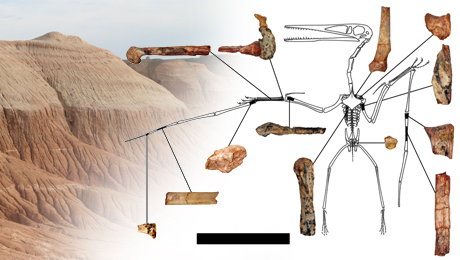A George Washington University professor is part of an international research team that has discovered and named the earliest and most primitive pterodactyloid—a group of flying reptiles that would go on to become the largest known flying creatures to have ever existed.
Working from a fossil discovered in northwest China, the project—led by University of South Florida paleontologist Brian Andres, James Clark of the GW Columbian College of Arts and Sciences and Xu Xing of the Chinese Academy of Sciences—named the new pterosaur species Kryptodrakon progenitor.
Through scientific analysis the team established it as the first pterosaur to bear the characteristics of the Pterodactyloidea, which would become the dominant winged creatures of the prehistoric world. The research establishes that the reptiles flew above the Earth some 163 million years ago, longer ago than previously known.
“This finding represents the earliest and most primitive pterodactyloid pterosaur, a flying reptile in a highly specialized group that includes the largest flying organisms,” says Chris Liu, program director in the National Science Foundation’s Division of Earth Sciences. “The research has extended the fossil record of pterodactyloids by at least 5 million years to the Middle-Upper Jurassic boundary about 163 million years ago.”
The fossil is of a small pterodactyloid with a wingspan estimate of about 4.5 feet. Pterodactyloids—who went on to evolve into giant creatures, some as big as small planes—went extinct with the dinosaurs, about 66 million years ago. Pterosaurs are considered close relatives to the dinosaurs, but are not dinosaurs themselves. The fossil was discovered in 2001 by Chris Sloan, formerly of National Geographic and now president of Science Visualization. It was found in a mudstone of the Shishugou Formation of northwest China on an expedition led by Drs. Xu and Clark when Dr. Andres was a graduate student with Dr. Clark at GW.
The desolate and harsh environment has become known to scientists worldwide as having “dinosaur death pits” for the quicksand in the area that trapped an extraordinary range of prehistoric creatures, stacking them on top of each other, including one of the oldest tyrannosaurs, Guanlong. Kryptodrakon progenitor was found 35 meters below an ash bed that has been dated back to more than 161 million years.
"Kryptodrakon is the second pterosaur species we've discovered in the Shishugou Formation and deepens our understanding of this unusually diverse Jurassic ecosystem,” said Dr. Clark, GW’s Ronald B. Weintraub Professor of Biology. “It is rare for small, delicate fossils to be preserved in Jurassic terrestrial deposits, and the Shishugou fauna is giving us a glimpse of what was living alongside the behemoths like Mamenchisaurus."
The name Kryptodrakon progenitor comes from Krypto (hidden) and drakon (serpent), referring to “Crouching Tiger, Hidden Dragon,” which was filmed near where the species was discovered, and progenitor for its status as the earliest pterodactyloid, Dr. Andres said.
Kryptodrakon progenitor lived around the time of the Middle-Upper Jurassic boundary. Through studying the fossil fragments, researchers also determined that the pterodactyloids originated, lived and evolved in terrestrial environments—rather than marine environments where other specimens have been found.
The area was likely a flood plain at the time the pterosaur lived, Dr. Andres said. As the pterosaurs evolved, their wings changed from being narrow, which are more useful for marine environments, to being more broad near the origin of the pterodactyloids – helpful in navigating land environments.
“He [Kryptodrakon progenitor] fills in a very important gap in the history of pterosaurs,” Dr. Andres said. “With him, they could walk and fly in whole new ways.”


